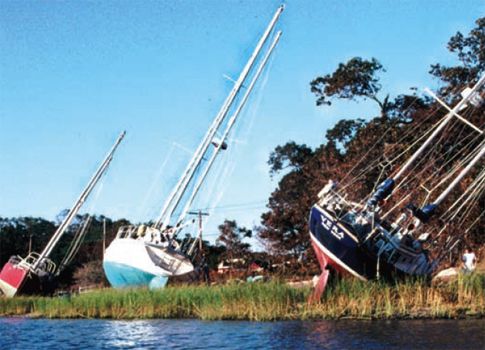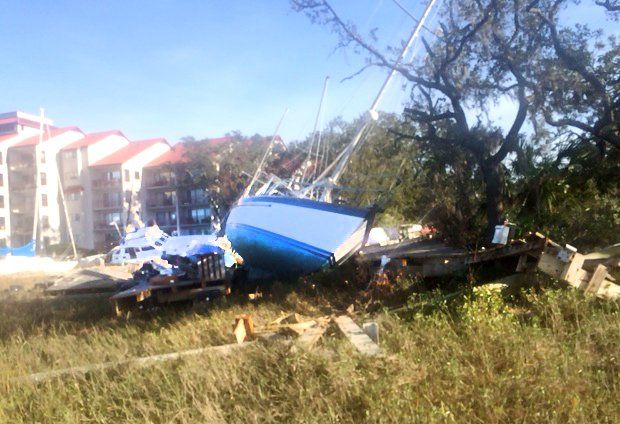If you are in the market for a used boat and live in a place where winter storage is the norm, autumn is one of the best times to bargain hunt. The owner is looking at another year of storage bills for a boat he no longer wants, and he knows that trying to sell a boat that is buttoned down for the winter is like trying to sell a house that is under a circus tent.
However, if you are anywhere near the pathway of a tropical storm or hurricane like Henri, which struck New England this week, or are buying a storm-damaged boat at auction, that bargain boat might well turn out to be more than you bargained for. Back in 2007, we published a special report on what happens when a fiberglass boat is subjected to the point loads that can occur during a storm. More recently, we offered a guide to the do-it-yourself survey that can help you identify cost-prohibitive repairs before paying for a professional survey. For the undaunted buyer who wants to wade hip deep into a restoration project, our guide to do-it-yourself boatyards can also help estimate the true costs of a long-term, do-it-yourself repair project.
How many post-Henri boats will end up on the market is not clear. Coastal flooding and storm surge was less than expected, and sustained wind speeds were below hurricane strength. The conditions in most New England harbors were within the range that a well-prepared boat can survive, and most boats survived unscathed, or with only minor damage. Nevertheless, we’ve already seen images of several sailboats driven ashore in Jamestown, RI and no doubt there are dozens of others along the nearby coast. Depending on where they landed, and the pounding they took, the damage could be significant or cosmetic.
After every hurricane, a number of boats aree picked up by salvagers and later returned to the market in New England. Many of these were total losses classified by insurers as Constructive Total Losses CTLs. Unfortunately, identifying a total loss, especially after it has crossed state lines and dressed up can be difficult. The tracking and reporting systems for salvaged vehicles that protect car buyers generally don’t exist for buyers of used boats.
Buying any used boat is truly caveat emptor; buying a storm damaged boat magnifies the risk to the buyer significantly. Any sign of severe flooding almost surely means the engine will need to be rebuilt or replaced. Likewise the electrical system may require a partial or complete rewiring. Severe structural issues can quickly turn a bargain boat into bottomless moneypit. Here are just three of the serious problems to look for.
Core damage – Once the outer skin of a cored hull or deck is breached, the core damage can spread widely. Most often, this is a long-term process as plywood or balsa (probably the most common core material in production sailboats) rots. A Matthew boat that has suffered a breached hull or deck might have damage limited to a small area that might be relatively easy to address. However, some core constructions can deteriorate rapidly when they become wet, in which case, a small hole can be the tip of the iceberg in terms of core damage. Even core that is not wet can suffer bond-failure, in which the outer fiberglass skin has pulled away from the core. This diminishes the structural integrity of the hull and can occur in areas far away from the point of impact.
Secondary bond failure – The chemical bonds between interior structures (such as bulkheads, pans and liners, and furniture) are generally not as strong as bonds formed during the molding process. As a storm-wrecked boat is battered on a beach or mudflat, unsupported areas of the hull will flex, stressing these secondary bonds to the point of failure. Unfortunately, many of these failed bond lines are hidden behind bulkheads, liners, and cabinets, virtually invisible until you start unscrewing furniture.

Hidden structural failure – Mast, keel, and rudder loads spread throughout the boats hull. This means that a simple grounding can cause damage in places far away from the point of impact. It is not uncommon that a boat that has grounded hard shows structural failures in unexpected areas of the deck, main bulkhead, or mast partners. Rudder damage is often the first sign of more serious problems in the bearings, rudder stock, or rudder framework. If the prop and shaft were subject to severe pounding, those impact loads surely transmitted to the strut and supporting structure.
Submerged engine – Beyond the obvious problems such as water-stained woodwork, ruined upholstery, and mold and mildew, there are less obvious problems associated with a boat that has sunk. A diesel engine that has been damaged by salt water can often be resurrected to run temporarily without addressing corrosion issues that can come back to haunt a new owner. Have an experienced mechanic closely inspect any storm damaged boat, and ask for receipts for any repairs to the engine. If it has been submerged and has no history of a rebuild, figure a complete rebuild (or new engine) into your budget, just to be safe.
We strongly encourage anyone contemplating buying a storm-damaged boat to work closely with an experienced surveyor. Taking on the challenge of restoring an insurance write-off is not for the faint of heart, and in many cases, does not make economic sense. However, more than a few cruisers are happily circling the world in boats they rebuilt from scratch. The good thing about this approach is that you know your boat inside and out. The bad thing is you know exactly what it cost you in blood, sweat, and dollars. Sadly, some Matthew boats will not be worth saving.









































Where is the Best place yo Buy used catamarans ir treemarans from 40 to 45 ft.
what is the best used sailboat with a full keel that still fits on a trailer and is the most economical an available?